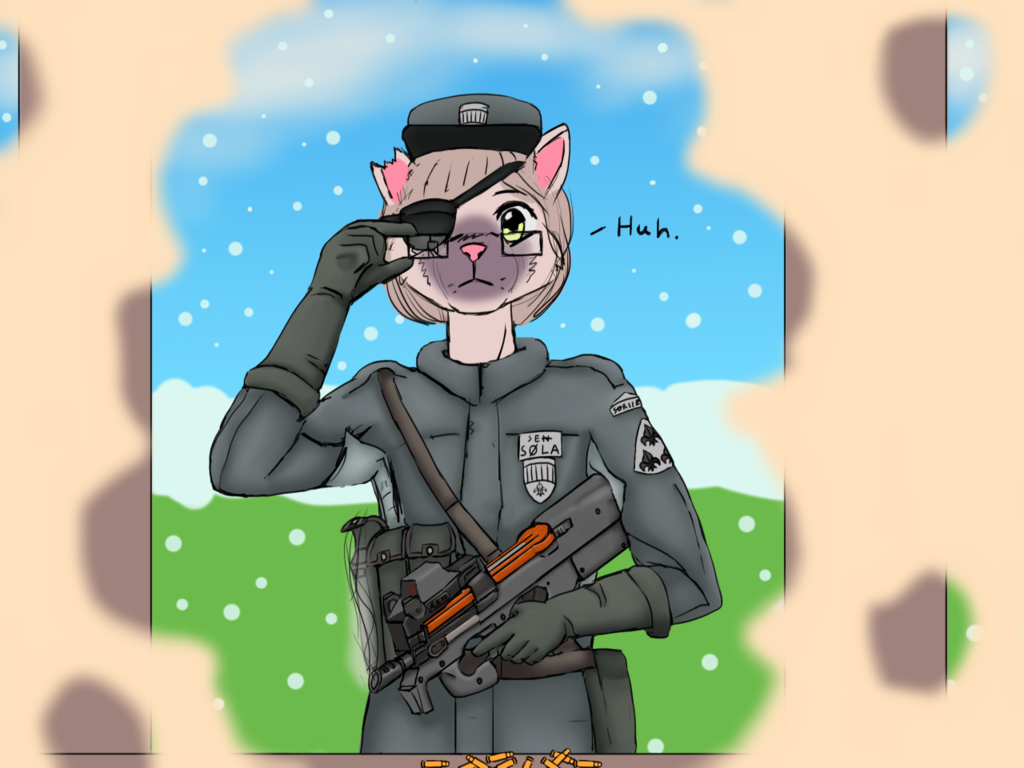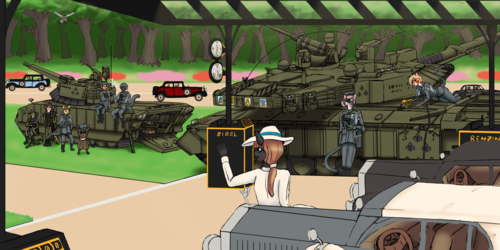Sign In
CloseShadings, yay. Also snow :D
Ingrid certainly wasn't expecting the new Type 70 SMG to actually be an improvement over her Type 45, but a Lady is always willing to consider the facts.
She was in fact fully primed to dislike it, given she was called away to start training with the Type 70 while she was on leave because one of her daughters-in-law was about to have her first grandchild (unrelated grandchild, since her first daughter's two wives are Chiran-born lemurs) and she was the one who was supposed to drive them to the hospital. She's also not normally a fan of plastic things and pretends she doesn't understand why she can't just use her original-production wood-furnished Type 45 instead of the synthetic-furnished one she'd been using prior to this.
(As a result, said granddaughter was actually born later that day on the back seat of her car when they got stuck in traffic slowed down by a worsening snowstorm.)
Ingrid has been in the military for long enough that the first weapon she trained with was Aludra's Reformation War-vintage Soren Model 91 .457 calibre top-break revolver when she was in finishing school, though by the time she actually joined her unit had already been issued with then-new Type 45 SMGs.
Aludra has historically always had great enthusiasm for submachine guns, and was the first to standardise one, the 8mm Type 413, shortly before the Reformation War. This was an overhead-loading, downward-ejecting fully-automatic firearm adapted for infantry use from surplus stocks of the notoriously useless Type 3 Aircraft Cannon, which became available when Aludran spotting aircraft switched to the infamous K3 "Skadi" rotary gun*.
The Type 45 is a derivative of the venerable Sabran Arsenal Type 37 Automatic Battle Rifle, and uses many of the same parts, with a blowback operating system rather than the short-stroke gas piston of the full-size rifle. Impressed with the performance of the Etrusean .45 Sterling compared to the various 8mm rounds used by their earlier SMGs and self-loading pistols, the Aludrans embarked on a protracted program spanning several minutes which ended in adopting ".45 Imperial," which only differs from .45 Sterling in that the standard projectile uses a steel core. Aludra has historically never been fond of using lead in bullets or musket balls; since Alun are obligate carnivores, they avoid throwing around things that might end being concentrated in the food chain.
Development of a more compact replacement began when it was first realised that Chiran 6x30mm AP cartridge, a shortened version of their 6x49mm assault rifle round fitted with a light armour-piercing bullet, was effective against soft body armour and able to inflict non-trivial organ damage to unarmoured Alcacians while being smaller and easier to handle than the .45 round.
Sabran Arsenal, Aludra's main arms manufacturer, set to work on a design heavily inspired by the Chiran weapon, using an unusual variation of Chira's preferred bullpup layout and making heavy use of modern polymers. The 50-round magazine was based on an unsuccessful Garamese prototype caseless rifle Adele sen Sabran had purchased for her family's private collection several years earlier, used a front-inserted, downward-facing magazine with a rotating chamber; Sabran's design instead faced conventional rounds to one side and used a spiral feed ramp integral to the magazine.
Several other major noble families joined with Sabran in creating the new design, including Aludra's most powerful family short of the Alud themselves, the Emera. Perhaps the most valuable was the Lindstrom family, descended from the maker of the world's first telescope; Lindstrom Optics designed and manufactured the internals of the reflex sight each weapon was to be fitted with.
Officially, prototypes of the Type 70 were first used during Operation Powder Keg, an action by Aludran paratroops to recapture a hijacked bulk natural gas tanker, though this was actually a result of the Aludran propaganda corps retouching photographs to erase that the paratroops were all carrying Chiran weapons and wearing mostly Chiran equipment**; the retouched photographs reflect the blocky early drawing-board iterations of the Type 70 rather than any firing model. In fact, it was this operation that convinced the Army that such a weapon could be effective, and paved the way for the Type 70 to be adopted at all. The first actual use was during a raid on a prison convoy by Aludra's top Special Forces unit, Force Five, which freed an Aludran spy being transported to her trial in Etrusea***, though this was denied. The production version was only officially confirmed with the general adoption just prior to Operation Anvil.
While the Force Five-issued preproduction Type 70s had transparent polycarbonate magazines and these were part of Sabran's specification for the final weapon, the full production order, 175,000 magazines for 25,000 guns, was impossible for the Aludran plastics industry to fulfill with their existing commitments. Instead the "A-pattern" magazine was hastily designed. This was made from Bakelite, but testing made it clear the 50-round capacity was too difficult to keep track of. This led to the final "B-pattern" magazine, which was the same Bakelite body with a cutout in the top for a clear plastic panel.
*The K3 gun was a unique solution to the early problem of firing through an aircraft's propeller without destroying it which used a gearbox linked directly to the engine to power the gun; properly adjusted, the weapon was physically incapable of hitting the prop. While the gun assembly was heavy and required extensive and precise maintenance (a popular urban legend based on a contemporary propaganda poster had it that an Aludran Army Flight Corps ground crew ground crew consisted of a mechanic, seamstress, armourer and watchmaker), the volume of fire and the switch from 8mm pistol cartridges to 8.1mm explosive rifle cartridges (banned for use by infantry, but argued to be acceptable in this role) made the otherwise mediocre Sabre monoplane a fearsome opponent and relatively capable ground-attack aircraft. In respect to traditional rules of land warfare (the ones the Empress did not feel like ignoring) aircraft sent on strafing missions against infantry used conventional ammunition.
**The more pessimistic senior officers who named the operation reasoned that at least this meant if they blew up the tanker they could blame the Chirans for it.
***This was due to an unusual Etrusean military law regarding mercy-killing, specifically that it is considered unlawful not to do so if an enemy requests such during wartime; when captured, the spy rather smugly handed over a declaration of war signed by the Empress, demanded her own immediate execution, and then handed over a declaration ending hostilities, a process sometimes called the "twenty second war." Since Etrusean law requires cases where the letter of the law is clearly being abused to be determined by a grand jury, this gave ample time for a recovery to be arranged before she could be interrogated; following this the law was amended to require the requesting enemy actually be injured in some way.
Submission Information
- Views:
- 550
- Comments:
- 0
- Favorites:
- 2
- Rating:
- General
- Category:
- Visual / Digital




